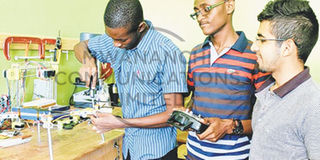Students bring drone technology to farmers

Young innovators. A group of students built a drone from scratch with the hope of using it in large-scale farm surveillance. PHOTO I CLARE CLANCY
What you need to know:
Maisam Pyarali says the project aims to empower farmers, giving them cutting-edge technology to monitor crops.
A team of university students building a drone from scratch say they plan to revolutionise farm surveillance technology in Tanzania.
Maisam Pyarali says the project aims to empower farmers, giving them cutting-edge technology to monitor crops.
“Technology is meant to simplify people’s lives,” he says. “With this team, we came together to see what we could do realistically within our time frame.”
He says most farmers monitor their crops by walking or driving around the land, which is time consuming and inefficient.
Essentially, a drone would allow a farmer to survey acres of land within minutes. Hazards, such as fires, would be more easily identified and the condition of the crops could be visualised more efficiently.
“Imagine having a 10-acre farm and doing surveillance in an old school way,” Pyarali says. “There’s a better way to do it.”
Major drawback
He adds that drone technology is already integrated into the global agricultural industry, but the high price of a drone is a major drawback for Tanzanian farmers.
“It costs almost $3,000 (Sh6.5 million) for a good drone,” he says. “When we came to the drawing board … we reverse engineered the whole thing, minimising as much of the cost as we could.”
Goodluck Shirima, who works on the mechanical aspects of the drone, says farm surveillance is time consuming and costly.
“We want it to make the lives of farmers easier for their survival,” he says.
He points out that drone maintenance is also a major factor. Experts need to be based in Tanzania to troubleshoot problems that may arise on farms.
“The experts on this drone are us, we are here in Tanzania. It is cheap and it can save time. If maintenance needs to be done, we can do it,” he says.
The six-person team, which works out of the Buni Hub, say they were strangers before the project, but were brought together by a shared vision.
They began designing the drone in July and have completed the first phase, meaning it is flight ready.
Now the team is looking for funding for the next phase — adding a state-of-the-art camera to capture the surveillance.
Operations Lead Musa Kamata, says Buni Hub, which was launched in 2011, is a co-working space fostering innovation, technology and entrepreneurship.
So far, the hub has drawn a lot of interest, Kamata says, with 100 people passing through every day. Currently, 4,000 people are registered.
“We are overwhelmed,” he says.
The hub offers programmes that focus on training, mentorship, community outreach and project management.
Solve problems in our community
“We believe with these skills they can solve problems in our community,” Kamata says, adding that participants learn how to prepare business models and how to analyse initial pitches.
“We to try to evaluate the idea, to learn whether it has potential in our community,” he says. “In every batch, we take one group to work in our main fabrication lab.”
One of the previous projects to come out of the lab involved building a 3D printer to create visual teaching aids for Tanzanian schools.
Pyarali says the printer came in use for the drone team because it provided a way to fabricate necessary plastic parts.
He adds that he was responsible for the drone design, ensuring that it could fly properly with the weight of a circuit board.
“We used aluminum frames. It’s sturdy but it’s also very light. We were trying to cut down on parts.”
Overall, he estimates the drone cost less than 400 USD to build. The main cost came from importing electronic parts that couldn’t be bought locally.
The eventual goal is to turn the project into a long-term business.
“We are looking at the market implications,” he says.
“Technically there weren’t too many obstacles we felt needed attention. The only thing we were worried about is the integration into society. How can we adapt this on the ground? It’s a challenge to change a mindset.”
Mkupete Mkamba, who works on the technical side of the project, says the team believes farmers will come around to the idea.
“Even large-scale farms outside Tanzania, they use drones,” he says. “It helps them to improve crop and production. We hope if you introduce the system in Tanzania they would use it.”
But the team knows they will face challenges if they plan to build a business that focuses solely on drone technology.
Pyarali says implementing mass production would be the toughest obstacle to overcome.
“Realistically it’s going to come down to that,” he says. “That’s how we have been trying to sell the concept.
“Imagine a farm when by the time you figure out there is a fire, or pests on one end, whatever is wrong has already progressed enough to cause some real damage. It’s quite an investment, yes. But ultimately there is a cumulative cost benefit, because you will be saving more in the long run.”
The drone, which has been successfully tested, is limited by its receiver and transmitter, which determine how far it can fly.
Currently it can fly 1.5 kilometres on a battery that lasts about 30 minutes. But the team has high hopes for future designs.
“The key concept we are trying to sell is how open source this is,” Pyarali says. “If you’d like it to go further it can be done.”
“It’s all open to modification.”




